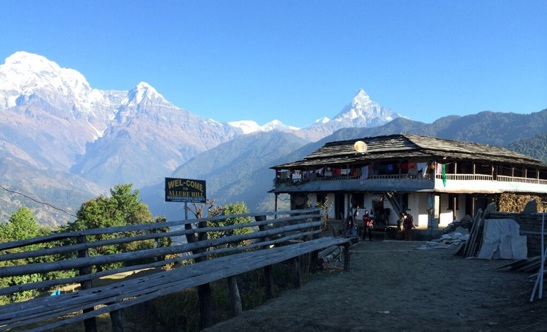
Obtaining Strategic Clarity of Thought: the Challenge for CEOs & Entrepreneurs
I recently read that CEO-designate Lim Ming Yan of CapitaLand sent over 100 emails from internet cafes while trekking in Nepal at the end of 2012. He was due to commence as CEO 1st January 2013. As public reports indicate, these emails contributed to the company’s transformation journey.
This did not surprise me at all.
When I first trekked in Nepal, I came back to Singapore with incredible clarity of mind, thought, and with renewed centeredness and inner strength. For me, there is something about doing something physical that stretches me (like climb up to a base camp) while letting the gentleness of the people and the beauty of those surreal mountains embrace me.
So, I can completely understand how one CEO-to-be would gain such clarity and intention while trekking in stunning Nepal.
However, it was also the focus of this thinking that struck me.
Procter & Gamble’s CEO addresses what he believes is the work of the CEO in a Harvard Business Review article (May 2009). Drawing from Drucker’s observations, he posits that only the CEO can (and should) do the following (1):
- Define and interpret the meaningful outside
- Answer, time and again, the two-part question, What business are we in and what business are we not in?
- Balance sufficient yield in the present with necessary investment in the future
- Shape the values and standards of the organisation.
When considering one’s organisation’s proposed growth and/or transformation journey, a CEO would definitely need to consider and gain clarity around all these issues. A CEO-designate would deliberately need to shift their thinking into this space as they transit into their new role. An entrepreneur would definitely need to consider similar issues to the CEO while also endeavouring to build an startup team and not be enticed to do everything themselves.
As I mused all of this, my mind immediately jumped in a few directions. Firstly, there is the dilemma around finding those moments of clarity, and secondly, finding the deep energy and alignment within to fuel and guide our thinking.
Side Benefits Of A Wandering Mind
Those moments of clarity in life, particularly the one’s that have great insight, can be so elusive, especially at times we feel we really need them. Ironically, it seems that the more we work to find these moments, the hard they seem to find!
However,
It happened to Archimedes in the bath. To Descartes it took place in bed while watching flies on his ceiling. And to Newton it occurred in an orchard, when he saw an apple fall. Each had a moment of insight. To Archimedes came a way to calculate density and volume; to Descartes, the idea of coordinate geometry; and to Newton, the law of universal gravity. (2)
So, it was a brilliant move for a CEO-designate to go trekking in Nepal in my mind.
There is something about a wandering mind, as Hotz indicates in his Science Journal article. The challenge for us is allowing ourselves the luxury of the time and space to allow our minds to wander in this fast moving and highly challenging world we live and work in. Ironically, this luxury may actually be essential.
Framing the Big Buckets for Our Wandering Minds
In their article about managing one’s energy, Schwartz and McCarty warn us about the ever demanding drive for higher performance in our organizations, and how we comply by often putting in longer hours. They suggest that this is, in fact, counter constructive as time is a limited resource. Personal energy is renewable and we can replenishing it in various simple ways by focusing on physical, mental, and emotional energy. They also mention spiritual energy that taps our human spirit, where meaning purpose align (3).
When our personal purpose and core values are given opportunity to reside happily and seamlessly with our organizational position or startup aspirations, we give our wandering minds the big bucket (or context) in which to wander, by implication.
It takes hard personal work in order to gain insight to where we get our deep energy and focus? We have to be deliberate about this, and continue to nurture ourselves to ensure we are fit to be at our ready best for those times that challenge our ability to endure or be resilient.
In Summary
In many ways, all this presents a dilemma. As CEOs and entrepreneurs, it is demanded of us to pay attention to balancing the external with the internal of their organisation/startup. Ambiguity and complexity abound. However, we all have natural tendencies which often results in us working harder and longer, being consumed with much when faced with the many unrelenting challenges of today. The job is often never done.
We need those moments of clarity and inspiration, and wisdom tells us we potentially find it in the counter-initutive times. It behoves us as CEOs and entrepreneurs to ensure we create “spaces” that enable us to think at our best, replenish our personal energy and set ourselves up for those moments of clarity and insight.
There are two dimensions in which we need to be deliberate:
– understanding what the mind-wandering “spaces” look like for us. If that means booking an annual trip to somewhere like Nepal to trek, make it happen!
– understanding ourselves so well that we can tap our deep energy including when we find ourselves in these “space”!
Success, whatever it means to you, may depend on this!
References
1. Lafley, A.G. (2009) “What Only the CEO Can Do”, Harvard Business Review, May
2. Hotz, R.L (2009), “A Wandering Mind Heads Straight Towards Insight), Science Journal, June 19th
3. Schwartz, T and McCarthy, C (2007) “Manage Your Energy Not Your Time”, Harvard Business Review, October

No Comments